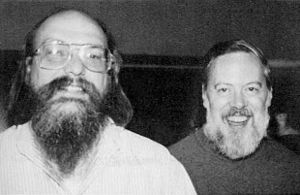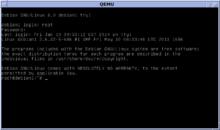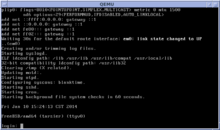Unix facts for kids
 |
|
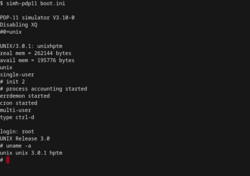
Unix System III running on a PDP-11 simulator
|
|
| Company / developer | Ken Thompson, Dennis Ritchie, Brian Kernighan, Douglas McIlroy, and Joe Ossanna at Bell Labs |
|---|---|
| Programmed in | C and assembly language |
| OS family | Unix |
| Source model | Historically proprietary software, while some Unix projects (including BSD family and Illumos) are open-source and historical Unix source code is archived. |
| Initial release | Development started in 1969 First manual published internally in November 1971 Announced outside Bell Labs in October 1973 |
| Available language(s) | English |
| Kernel type | Varies; monolithic, microkernel, hybrid |
| Influenced by | CTSS, Multics |
| Default user interface | Command-line interface and Graphical (Wayland and X Window System; Android SurfaceFlinger; macOS Quartz) |
| License | Varies; some versions are proprietary, others are free/libre or open-source software |
| Internet history timeline |
|
Early research and development:
Merging the networks and creating the Internet:
Commercialization, privatization, broader access leads to the modern Internet:
Examples of Internet services:
|
Unix is a family of computer operating systems. It allows many tasks to run at once (multitasking). It also lets many users use the same computer at the same time (multi-user). Unix started being developed in 1969 at Bell Labs. Key people like Ken Thompson and Dennis Ritchie worked on it.
At first, Unix was used mainly within AT&T. Later, AT&T allowed other groups to use it. This led to many different versions of Unix. These versions came from places like the University of California, Berkeley (called BSD) and companies like Microsoft (Xenix). Other big companies like Sun Microsystems and IBM also made their own Unix versions.
Early Unix versions ran on computers like the PDP-11. Unix became popular on minicomputers and mainframes in the 1970s. It was special because it was the first operating system that could easily work on different types of computers. This is called being "portable." Most of Unix was written in the C programming language in 1973.
Unix systems follow a "Unix philosophy" or modular design. This means the operating system has many small tools. Each tool does one specific job very well. These tools can be linked together using "pipes." This allows them to perform more complex tasks. A special program called a shell lets users type commands to control the system.
In 1979, Version 7 Unix was the last widely released "Research Unix." AT&T then sold commercial versions like UNIX System III (1982) and UNIX System V (1983). Because these were not open, the University of California, Berkeley kept developing BSD. Over time, many commercial Unix versions were based on either System V or BSD. In 1989, AT&T and Sun combined features from different Unix versions into UNIX System V Release 4 (SVR4).
In 1992, AT&T sold Unix to Novell. Novell later sold the UNIX trademark to The Open Group. This group now allows operating systems to use the "UNIX" name if they meet certain rules. Since the 1990s, Unix systems have appeared on home computers. Free versions like FreeBSD and Linux became very popular. Until 2005, Unix was the most used operating system for servers. Today, Unix versions like IBM AIX and Oracle Solaris are still used in specific areas.
Contents
How Unix Works
Unix was first made for programmers to create software. It grew as more users added their own tools and shared them.
At first, Unix was not designed for many tasks or to be portable. But it soon gained these abilities. Unix systems use plain text for storing data. They have a hierarchical file system, like folders within folders. Devices like printers are treated like files.
Unix uses many small programs called "software tools." These tools can be linked together using "pipes." This is done through a command-line interpreter. This idea is called the "Unix philosophy." It means the system's power comes from how programs work together.
By the early 1980s, people saw Unix as a possible operating system for all computers. Unix helped develop the Internet. It changed how computers worked, making them more connected in networks.
Both Unix and the C programming language were created by AT&T. They were shared with universities and government groups. This helped them work on many different types of machines.
The Unix operating system has many parts. It includes libraries, tools, and the main control program, the kernel. The kernel helps start and stop programs. It manages the file system and other basic tasks. It also makes sure programs don't try to use the same part of the computer at the same time. The kernel has special permissions to do this.
The Story of Unix
The idea for Unix came from a project in the mid-1960s. This project was called Multics. It was a system for sharing computer time on a large computer. Researchers at Bell Labs, like Ken Thompson and Dennis Ritchie, were part of the Multics project. They found Multics too big and complex. So, they decided to create a smaller, simpler system.
This new system started without a name or official support. In 1970, the group called it Unics. This was a playful name, a "pun," on Multics. The name Unics stood for Uniplexed Information and Computing Service. Later, the spelling changed to Unix.
Unix was first written in a low-level language called assembly language. But in 1973, Version 4 Unix was rewritten in C. This made it easier to move Unix to different computers. The first time Unix was moved to a different computer was in 1977.
Bell Labs made several versions of Unix, known as Research Unix. In 1975, the first license to use UNIX was sold to a university.
In the late 1970s and early 1980s, Unix became very popular in schools. This led to many companies creating their own versions of Unix. These versions were similar but sometimes didn't work perfectly together. Examples include HP-UX and Solaris. To fix this, AT&T and Sun Microsystems worked together. They created System V Release 4 (SVR4) in 1989. Many companies then used SVR4 as their base.
In the 1990s, Unix and Unix-like systems grew even more popular. They became the top choice for most of the world's fastest supercomputers. This was thanks to free versions like BSD and Linux. In 2000, Apple released Darwin. This was also a Unix system and became the core of macOS.
Today, Unix-like operating systems are widely used. You can find them in servers, workstations, and mobile devices.
Unix Standards
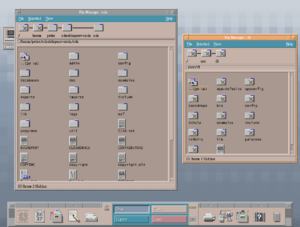
In the late 1980s, people started working on common rules for operating systems. This effort is known as POSIX. IEEE created POSIX based on the main Unix versions. The first POSIX standard came out in 1988.
In the early 1990s, another similar effort began. This was the Common Open Software Environment (COSE) initiative. It later became the Single UNIX Specification (SUS). This is managed by The Open Group. Since 1998, The Open Group and IEEE have worked together. They created a common definition for POSIX and the Single UNIX Specification.
In 1999, many Unix companies agreed on a standard for program files. This was called Executable and Linkable Format (ELF). This format helps different Unix systems work with the same programs.
The Filesystem Hierarchy Standard was made to suggest how directories should be organized. It is mostly used in Linux systems.
Parts of Unix
The Unix system is made of several parts that were originally put together. It included the tools for creating software, libraries, and documents. It also had the main program, the kernel, and its source code. This meant Unix was a complete software system. This was a big reason why it became important for teaching and learning.
The original Unix system was not huge. It fit on a single magnetic tape. This showed how portable the system was.
The names and locations of Unix parts have changed over time. But an early version, V7 Unix, had a common structure:
- Kernel: This is the core of the operating system. It manages memory, schedules programs, and handles basic tasks.
- Development tools: Early Unix versions had everything needed to build the system from scratch.
- ed: A text editor for writing code.
- cc: The C language compiler.
- as: An assembler for machine language.
- ld: A linker to combine program parts.
- lib: Libraries of code, like the libc.
- make: A tool to automate building software.
- Commands: These are programs users run.
- sh: The "shell" is a program where users type commands. It was the main way to use Unix before graphical interfaces.
- Utilities: A set of basic tools like cp (copy), ls (list files), and grep (search text).
- Document tools: Programs for preparing and printing documents.
- Graphics: Tools for creating simple drawings. Later, X11 became the standard for graphical interfaces.
- Communications: Programs for sending messages between users, like mail. Later, UUCP and TCP/IP tools were added for network communication.
- Documentation: Unix was one of the first systems to have all its help files online.
- man: Manual pages for every command and part of the system.
Unix's Big Influence

The Unix system greatly influenced other operating systems. It became popular because it was interactive. It was also cheap for schools to use. It ran on affordable computers and was easy to change and move. Unix was first written in assembly language. But it was soon rewritten in C, a high-level programming language. This made it much easier to use.
Unix had a very simple way of handling files. It treated all files as simple lists of bytes. This was different from many other systems at the time. The file system was organized like a tree, with folders inside folders. This idea was first seen in Multics, but Unix made it popular.
Unix also made the command interpreter a regular program. This meant users could choose their own shell. New commands could be added without changing the shell itself. Unix's way of linking programs together with "pipelines" was very powerful. Many later command-line programs were inspired by Unix.
A key idea in Unix was using newline-separated text for almost all files. This made Unix pipes very useful. It encouraged creating simple tools that could be easily combined. This focus on text made the system much more flexible and portable.
The Unix programming rules became the basis for a standard called POSIX. The C programming language also spread beyond Unix. It is now used everywhere in programming.
Early Unix developers helped bring ideas like modularity (breaking programs into small parts) and reusability (using parts again) into software design. They created a "software tools" movement. The people who developed Unix also set up a way of thinking about software. This is called the Unix philosophy.
The TCP/IP networking protocols were quickly put into Unix. This helped the Internet grow rapidly. It allowed computers worldwide to connect in real-time.
Unix's policy of having lots of online help and access to its source code raised expectations for programmers. This helped start the free software movement in 1983.
Free Unix and Unix-like Systems
In 1983, Richard Stallman started the GNU project. GNU stands for "GNU's Not Unix." It aimed to create a free software system like Unix. "Free" meant anyone could use, study, change, and share it. The GNU project's own kernel, GNU Hurd, was still being developed. But in 1991, Linus Torvalds released the Linux kernel as free software. Many GNU tools, like the GNU Compiler Collection, are used in Linux and other free Unix systems.
Linux distributions, which combine the Linux kernel with other software, are very popular. They are used by individuals and businesses. Some popular Linux versions include Red Hat Enterprise Linux, Fedora, Debian, and Ubuntu.
A free version of BSD Unix, called 386BSD, came out in 1992. This led to the NetBSD and FreeBSD projects. After a lawsuit in 1994, it was clear that Berkeley could share BSD Unix for free. Since then, BSD Unix has developed into different versions, like OpenBSD.
Because Unix is designed in a modular way, its parts are often shared. Most Unix and Unix-like systems use some BSD code. Many also use GNU tools. Linux and BSD Unix are now used in many areas. These include desktop computers, mobile devices, and embedded devices.
In 1999, Dennis Ritchie, one of Unix's creators, said that Linux and BSD Unix are a continuation of Unix's design. He saw them as direct descendants of Unix. He believed they continued the ideas started by him and Ken Thompson many years ago.
OpenSolaris was a free version of Solaris. It was developed by Sun Microsystems. However, Oracle stopped the project when they bought Sun. This led to a new project called illumos. As of 2014, illumos is the only active, open-source version based on System V.
ARPANET Connection
In 1975, a document described "Network Unix." This was developed at the University of Illinois Urbana-Champaign. Unix was seen as a good system for connecting to the ARPANET. At that time, a Unix license cost $20,000 for companies. But universities could get one for only $150.
The document noted that Unix offered powerful tools for users. It had compilers, an editor, and a good file system. It treated network connections like special files. This meant they could be accessed using standard Unix commands. This also helped close all connections when a program finished. To keep the main Unix kernel small, much of the network code ran as a separate user program.
Unix Branding
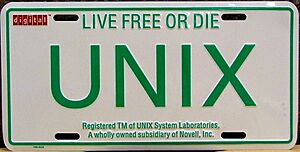
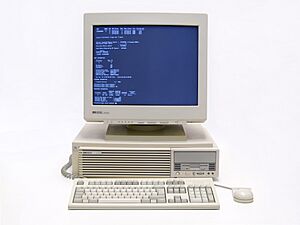
AT&T first did not let companies use the Unix name. So, Microsoft called its version Xenix. In 1988, AT&T allowed using the UNIX trademark for systems based on System V Release 3.2. In 1993, Novell, which owned the rights to Unix System V, sold the UNIX trademarks to the X/Open Company. This company is now The Open Group.
The current owner of the trademark UNIX is The Open Group. Only systems that follow the Single UNIX Specification can be called "UNIX." Other similar systems are called "Unix-like."
The Open Group says that "UNIX" should always be used as an adjective. For example, "UNIX system." This helps keep it from becoming a general word.
The original spelling was Unix. But UNIX is also widely used. This is because it was once printed in small capital letters. It is not an acronym.
The word "Unix" has also been used for other products. These include bookshelves, pens, and food containers. This is because trademark laws can allow the same name for different types of products.
People use different plural forms for Unix. The most common is Unixes. Sometimes, Unices is used, treating Unix like a Latin word.
See also
 In Spanish: Unix para niños
In Spanish: Unix para niños
- Comparison of operating systems
- List of operating systems
- List of Unix systems
- List of Unix commands
- Plan 9 from Bell Labs
- Timeline of operating systems
- Unix time
- Market share of operating systems
- Year 2038 problem



